T-Wing Video Clips
Free Flight with
Transitions: 30/August/2006
The video
below shows a free flight performed with both transitions on 30/August 2006. The
vehicle performed the first transition fully autonomously and navigated to the
first horizontal waypoint and turned on to the second fully autonomously but
was then put in a semi-autonomous mode due to excessive altitude loss in the
turn (due to a small problem in the flight controller – since fixed). With the
pilot supplying high-level guidance commands for the vehicle’s low-level
controllers, the vehicle was transitioned back to vertical flight and recovered
safely. In the video the following aspects are seen:
v
Vehicle
climbs up to a waypoint at 100 ft;
v
It
then continues climbing to a further waypoint at 300 ft;
v
It
then transitions fully autonomously away from the wind in the correct attitude.
During the transition it loses approximately 3 metres in altitude;
v
It
then navigates to the first horizontal waypoint and turns towards the second
autonomously;
v
During
the turn the vehicle loses significant altitude due to a small control system
error (excessively tight saturation limits on some integral states in the
pitch-rate controller);
v
The
pilot takes over high-level guidance and brings the vehicle back towards the
runway (supplying pitch angle, and bank-angle commands);
v
The
ground-pilot commands the vehicle to perform a horizontal to vertical
transition which it does in about 50m of altitude.
v
The
video is also cut to shorten the time of the descent portion of the flight
(about 2 minutes in the actual flight)
v
The
vehicle lands in a vertical attitude.
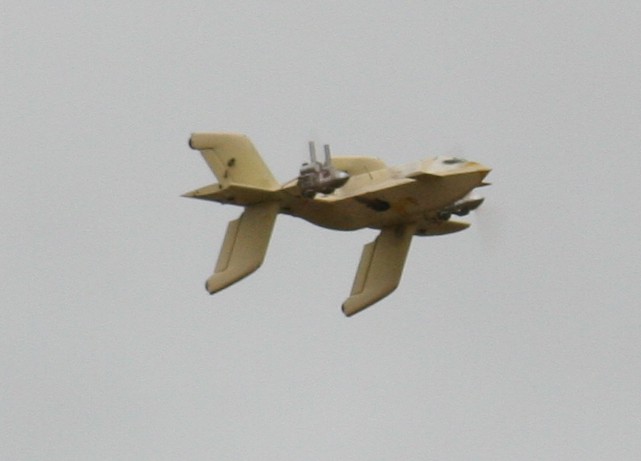
Transition
Flight 30Aug2006_ (~12MB)
Free Flight with
Transitions: 1/August/2006
The video
below shows a free flight performed with both transitions on 1/August/2006. The
vehicle was accidentally put into a fully manual mode [due to bad
ground-station ergonomics] during the flight and lost control, but was
recovered in a semi-manual mode and landed without a scratch. The video has
been edited to delete the unintended control departure region. In the video the
following things are seen:
v
Vehicle
climbs up to a waypoint at 100 ft;
v
It
then continues climbing to a further waypoint at 300 ft;
v
It
then transitions into the wind on its back and rolls right way up while in
autonomous mode;
v
At
this stage the manual switch was inadvertently hit and the vehicle departed
controlled flight;
v
The
video resumes with the vehicle recovered in a semi-manual mode;
v
The
ground-pilot commands the vehicle to perform a horizontal to vertical
transition which it does in about 50m of altitude.
v
The
video is also cut to shorten the time of the descent portion of the video
(about 2 minutes in the actual flight)
v
The
vehicle then lands in a vertical attitude.
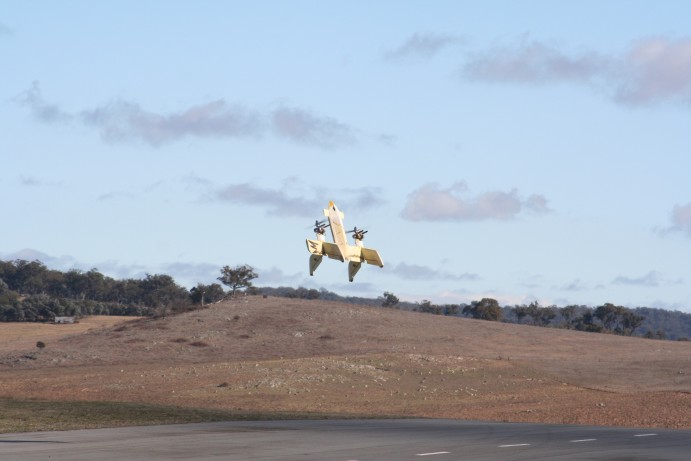
Transition Flight 1 August
2006 (15.08 MB)
Model Predictive Control
Flights 28/July/2006
On 28th
July 2006 the vehicle completed its first 100% successful Model Predictive
Control (MPC) Flights on the tether test-rig. During these flights the vehicle
performed the standard “+” pattern while in hover-mode vertical flight. The
vehicle used an MPC algorithm looking ~2.5 seconds into the future to determine
the optimal control to apply at any given point in time. The particular
manifestation of the MPC algorithm used here has been developed by Peter
Anderson as part of his PhD studies and runs on the 400MHz Celeron flight
computer. For some of the predictive flights the vehicle was flown with an
ultrasonic wind-sensor to capture the relative wind-information.
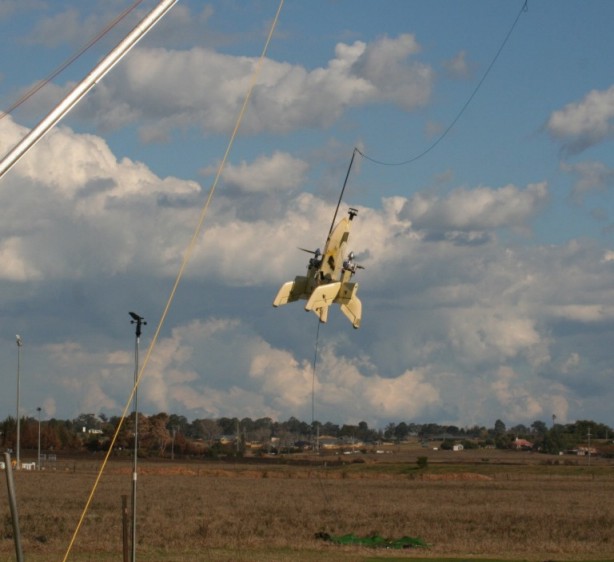
Model Predictive
Control Flight 28/July/2006: ultra-sonic wind-sensor on nose in picture (not video)
Fully Autonomous Tethered
Testing with New Avionics: November 2005
The videos
below show the vehicle performing a fully autonomous flight from takeoff through
to landing. During this flight the vehicle passes through a total of 26
way-points before landing autonomously. The waypoints consist of the following maneuvers:
v
Climb
10 ft and hover.
v
Move
in a Cross-Pattern (“+”) with 8 ft legs in North, then South, then East and
then West directions with belly facing North. This demonstrates vertical
translations in directions aligned with major vehicle axes.
v
Reorient
belly 45 degrees to point North-East.
v
Repeat
Cross-Pattern with 8 ft legs in North, South, East and West directions to
demonstrate vertical translations at oblique angles to the normal vehicle axis
system.
v
Reorient
Belly pointing North.
v
Perform
clock-wise hesitation vertical role, stopping at each major compass point
(NESW).
v
Perform
similar anti-clockwise hesitation vertical role.
v
Climb
to 12 ft altitude;
v
Descend
to 4 ft;
v
Land.

Fully
Autonomous Flight: Lo-Res: MPEG1 352x288 (47 MBytes)
Fully
Autonomous Flight: Hi-Res: MPEG2 720x576 (213 MBytes)
Fully
Autonomous Flight: Lo-Res: WMV 640x480 (20 MBytes)
Fully
Autonomous Flight: Med Res: WMV 720x576 (70 MBytes)
T-Wing Resumes
Flight Testing (1/March/2005)
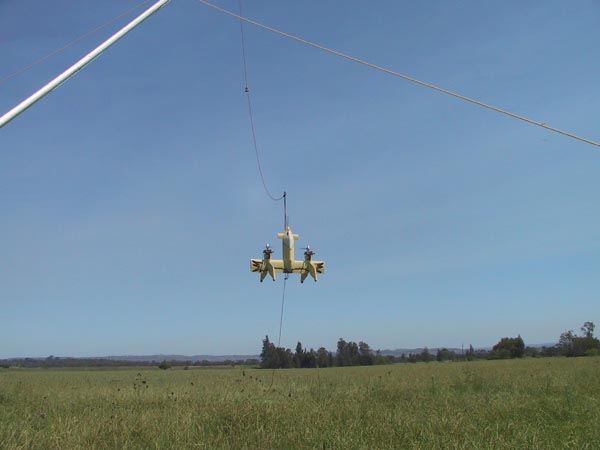
T-Wing
Tethered Test Flight: 1/March/2005
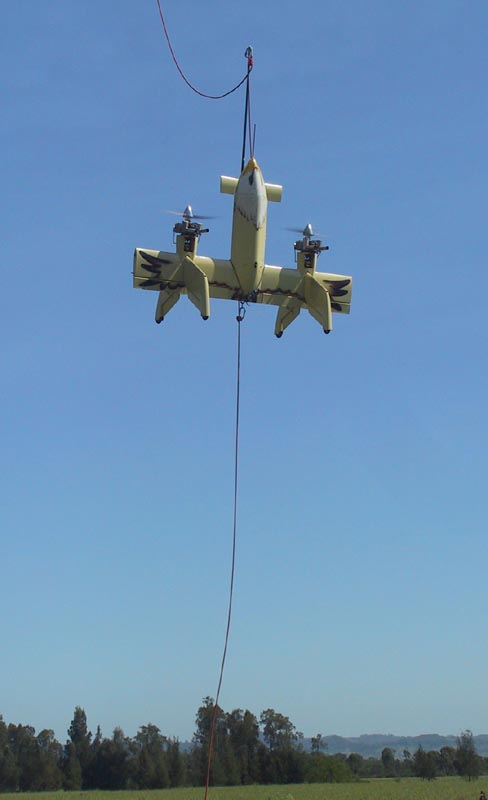
Short
(MPEG2 Format: 720x576): 30.6 M
Longer
(MPEG2 Format: 720x576): 64.9 M
Full Autonomous Take-off:
12/Sep/2002
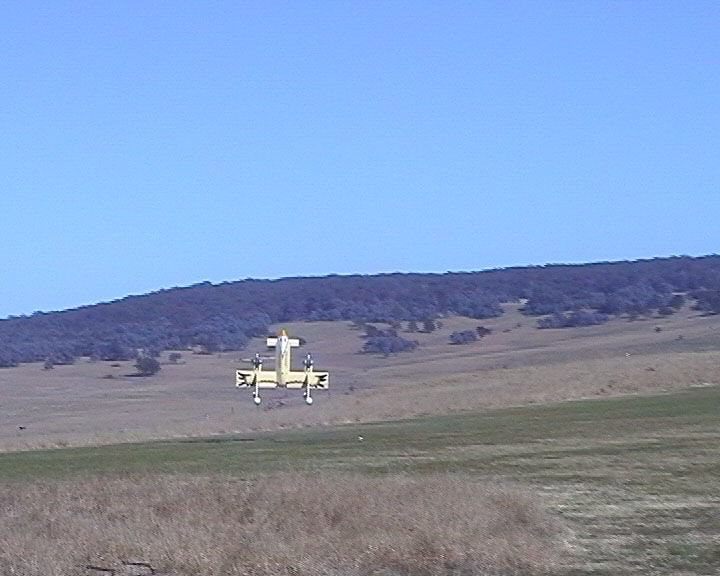
Hi Res Video –
14.5Mb (MPEG2 format - 720x576,
download codecs or player)
Lo Res Video – 3.6Mb (MPEG1
format - 352x288)
Hover Flight Using
Velocity Controllers
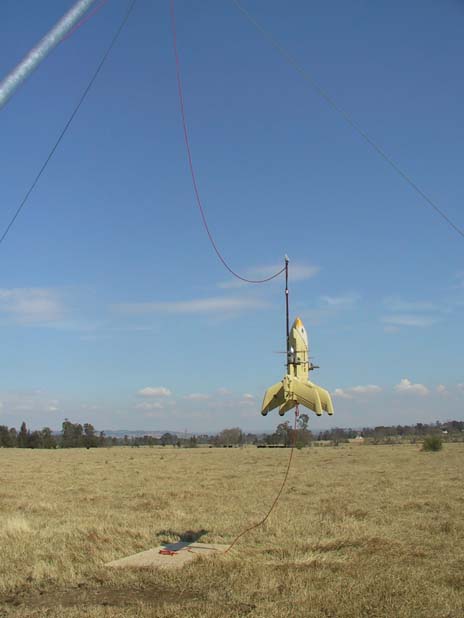
Last
revised: Thursday, 3rd August, 2006.